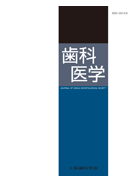Volume 63, Issue 2
Displaying 1-39 of 39 articles from this issue
- |<
- <
- 1
- >
- >|
-
Article type: Article
2000 Volume 63 Issue 2 Pages 113-128
Published: June 25, 2000
Released on J-STAGE: April 17, 2017
Download PDF (1844K) -
Article type: Article
2000 Volume 63 Issue 2 Pages 129-141
Published: June 25, 2000
Released on J-STAGE: April 17, 2017
Download PDF (1503K) -
Article type: Article
2000 Volume 63 Issue 2 Pages 142-154
Published: June 25, 2000
Released on J-STAGE: April 17, 2017
Download PDF (2412K) -
Article type: Article
2000 Volume 63 Issue 2 Pages 155-160
Published: June 25, 2000
Released on J-STAGE: April 17, 2017
Download PDF (743K) -
Article type: Article
2000 Volume 63 Issue 2 Pages 161-166
Published: June 25, 2000
Released on J-STAGE: April 17, 2017
Download PDF (937K)
-
Article type: Article
2000 Volume 63 Issue 2 Pages 167-
Published: June 25, 2000
Released on J-STAGE: April 17, 2017
Download PDF (170K) -
Article type: Article
2000 Volume 63 Issue 2 Pages 168-
Published: June 25, 2000
Released on J-STAGE: April 17, 2017
Download PDF (172K) -
Article type: Article
2000 Volume 63 Issue 2 Pages 169-
Published: June 25, 2000
Released on J-STAGE: April 17, 2017
Download PDF (172K)
-
Article type: Article
2000 Volume 63 Issue 2 Pages 170-
Published: June 25, 2000
Released on J-STAGE: April 17, 2017
Download PDF (182K) -
Article type: Article
2000 Volume 63 Issue 2 Pages 170-171
Published: June 25, 2000
Released on J-STAGE: April 17, 2017
Download PDF (349K) -
Article type: Article
2000 Volume 63 Issue 2 Pages 171-
Published: June 25, 2000
Released on J-STAGE: April 17, 2017
Download PDF (221K) -
Article type: Article
2000 Volume 63 Issue 2 Pages 171-172
Published: June 25, 2000
Released on J-STAGE: April 17, 2017
Download PDF (358K) -
Article type: Article
2000 Volume 63 Issue 2 Pages 172-173
Published: June 25, 2000
Released on J-STAGE: April 17, 2017
Download PDF (216K)
-
Article type: Article
2000 Volume 63 Issue 2 Pages 31-32
Published: June 25, 2000
Released on J-STAGE: April 17, 2017
Download PDF (274K) -
Article type: Article
2000 Volume 63 Issue 2 Pages 33-34
Published: June 25, 2000
Released on J-STAGE: April 17, 2017
Download PDF (231K) -
Article type: Article
2000 Volume 63 Issue 2 Pages 35-36
Published: June 25, 2000
Released on J-STAGE: April 17, 2017
Download PDF (258K) -
Article type: Article
2000 Volume 63 Issue 2 Pages 36-37
Published: June 25, 2000
Released on J-STAGE: April 17, 2017
Download PDF (274K) -
Article type: Article
2000 Volume 63 Issue 2 Pages 38-39
Published: June 25, 2000
Released on J-STAGE: April 17, 2017
Download PDF (266K) -
Article type: Article
2000 Volume 63 Issue 2 Pages 41-
Published: June 25, 2000
Released on J-STAGE: April 17, 2017
Download PDF (141K) -
Article type: Article
2000 Volume 63 Issue 2 Pages 42-
Published: June 25, 2000
Released on J-STAGE: April 17, 2017
Download PDF (127K) -
Article type: Article
2000 Volume 63 Issue 2 Pages 43-44
Published: June 25, 2000
Released on J-STAGE: April 17, 2017
Download PDF (323K) -
Article type: Article
2000 Volume 63 Issue 2 Pages 45-46
Published: June 25, 2000
Released on J-STAGE: April 17, 2017
Download PDF (253K) -
Article type: Article
2000 Volume 63 Issue 2 Pages 46-47
Published: June 25, 2000
Released on J-STAGE: April 17, 2017
Download PDF (270K) -
Article type: Article
2000 Volume 63 Issue 2 Pages 48-49
Published: June 25, 2000
Released on J-STAGE: April 17, 2017
Download PDF (248K) -
Article type: Article
2000 Volume 63 Issue 2 Pages 49-50
Published: June 25, 2000
Released on J-STAGE: April 17, 2017
Download PDF (285K) -
Article type: Article
2000 Volume 63 Issue 2 Pages 51-52
Published: June 25, 2000
Released on J-STAGE: April 17, 2017
Download PDF (279K) -
Article type: Article
2000 Volume 63 Issue 2 Pages 52-53
Published: June 25, 2000
Released on J-STAGE: April 17, 2017
Download PDF (310K) -
Article type: Article
2000 Volume 63 Issue 2 Pages 54-55
Published: June 25, 2000
Released on J-STAGE: April 17, 2017
Download PDF (264K) -
Article type: Article
2000 Volume 63 Issue 2 Pages 56-57
Published: June 25, 2000
Released on J-STAGE: April 17, 2017
Download PDF (303K) -
Article type: Article
2000 Volume 63 Issue 2 Pages 58-59
Published: June 25, 2000
Released on J-STAGE: April 17, 2017
Download PDF (247K) -
Article type: Article
2000 Volume 63 Issue 2 Pages 60-61
Published: June 25, 2000
Released on J-STAGE: April 17, 2017
Download PDF (271K) -
Article type: Article
2000 Volume 63 Issue 2 Pages 62-63
Published: June 25, 2000
Released on J-STAGE: April 17, 2017
Download PDF (251K) -
Article type: Article
2000 Volume 63 Issue 2 Pages 64-65
Published: June 25, 2000
Released on J-STAGE: April 17, 2017
Download PDF (252K) -
Article type: Article
2000 Volume 63 Issue 2 Pages 65-66
Published: June 25, 2000
Released on J-STAGE: April 17, 2017
Download PDF (273K) -
Article type: Article
2000 Volume 63 Issue 2 Pages 67-68
Published: June 25, 2000
Released on J-STAGE: April 17, 2017
Download PDF (278K) -
Article type: Article
2000 Volume 63 Issue 2 Pages 68-69
Published: June 25, 2000
Released on J-STAGE: April 17, 2017
Download PDF (295K) -
Article type: Article
2000 Volume 63 Issue 2 Pages 70-71
Published: June 25, 2000
Released on J-STAGE: April 17, 2017
Download PDF (273K) -
Article type: Article
2000 Volume 63 Issue 2 Pages 71-72
Published: June 25, 2000
Released on J-STAGE: April 17, 2017
Download PDF (292K) -
Article type: Article
2000 Volume 63 Issue 2 Pages 73-74
Published: June 25, 2000
Released on J-STAGE: April 17, 2017
Download PDF (245K)
- |<
- <
- 1
- >
- >|
